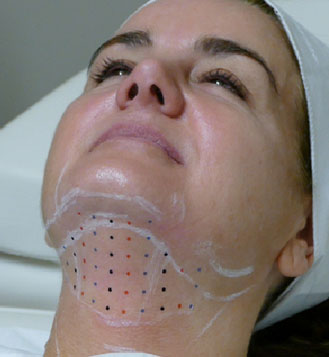
Few accomplishments are as rewarding as waking up in the morning and hitting your target weight. You've worked hard to drop those unwanted pounds all year long, and you deserve a huge round of applause for what you've accomplished. However, if you're like many men and women, getting the sleek, sculpted body you crave is easier said than done. You've got pockets of unwanted fat around your abdomen, thighs, chin, and other areas - fat that just won't go away, despite diet and exercise.
Wouldn't it be nice to just freeze that fat away and forget all about your love handles?
At Southern Cosmetic Laser, our new, revolutionary fat-freezing treatment can help you achieve the toned look you've been dreaming of. That's right - we're talking about literally freezing the unwanted fat off your problem areas without invasive surgeries or extended downtime.
This amazing treatment is called CoolSculpting, and it's the world's leading non-invasive fat reduction procedure. It's specifically designed for people already at their desired weight who want to push past that plateau for real body sculpting results. If you're tired of seeing that excess belly fat, saggy skin, or double chin, CoolSculpting is the procedure for you. Southern Cosmetic Laser offers a wide range of the newest technologies to target fat reduction, skin tightening, facial and body remodeling, body toning, and cellulite reduction.

Our Services
Services Area

What is CoolSculpting?

CoolSculpting is an FDA-approved procedure that has undeniable results. With CoolSculpting, you can permanently get rid of your muffin top, fat around your flanks, and more, all from the comfort and convenience of the Southern Cosmetic Laser office.
Technically known as cryolipolysis, CoolSculpting has the ability to reduce the number of fat cells in targeted areas between 20 and 25%. This unique technology uses controlled cooling to freeze and eliminate fat with minimal recovery time. No needles, no scalpels, no liposuction. Just real results provided by a licensed, experienced professional.
While CoolSculpting helps eliminate fat cells in your body, it doesn't harm the surrounding skin and muscles. Instead, it treats fat that is directly under the skin, also called subcutaneous fat. Since CoolSculpting doesn't target visceral fat deposits, this treatment works best for men and women who are approaching or already at their desired weight.
CoolSculpting is approved by the FDA to help reduce fat in the following areas:
- Flanks
- Outer Thighs
- Upper Arms
- Inner Thighs
- Chin
- Back
- Belly and Abdomen
How Does CoolSculpting Work?

CoolSculpting results are noticeable, proven, and long-lasting, helping you look your best and feel great from every angle. This exciting procedure works because fat cells freeze at higher temps than other tissues. As such, CoolSculpting delivers controlled, targeted cooling to do away with unwanted fat underneath your skin. These fat cells are essentially frozen or crystallized and eventually die. With time, your body will process that fat and will eliminate the dead cells, leaving behind a more sculpted physique.
Here are some quick CoolSculpting facts at a glance, so you have a better idea of why this fat cell elimination treatment is so popular:
- There is no prep time required for CoolSculpting from Southern Cosmetic Laser.
- Patients can expect some very minor discomfort during the procedure. Many patients report no discomfort at all.
- There is little-to-no downtime needed after your CoolSculpting procedure is complete.
- It may take up to 12-16 weeks to see your final results.
- This procedure eliminates fat permanently!

Southern Cosmetic Laser's CoolSculpting Procedure

Our CoolSculpting procedure is crafted around your comfort, with one-on-one attention in a relaxing atmosphere. It all starts with a detailed assessment, which you will complete prior to your treatment. This assessment will help us better understand your goals and desires, so we can freeze away the stubborn fat from the areas that matter most.
Typical CoolSculpting appointments take about an hour per area, though that time varies with each patient. Because our CoolSculpting applicators use a vacuum system to help with placement, you may feel a pulling sensation in the targeted area. Once placement is complete, we get to work on freezing your fat.
Before treatment, your skin is prepped with an alcohol wipe. A gel pad is then placed on your treatment area to help protect your skin. From there, a cold sensation is delivered through our applicators, which are designed for specific body parts.
Because there is no sedation involved with CoolSculpting, we encourage you to kick back, relax, and watch a little TV. If you prefer, you can also read or use your phone to check your favorite social media sites. Our friendly, experienced CoolSculpting technicians strive to keep you as comfy as possible during this quick treatment. When it's over, you can resume normal activities as soon as you like - there's no recovery or downtime to worry about!


Top CoolSculpting Treatment Areas

CoolSculpting procedures are perhaps best known for eliminating stubborn belly fat, giving the patient a desirable, contoured tummy. However, this treatment is also very effective on other areas of your body:
CoolSculpting for Your Double Chin
While neck fat usually goes hand-in-hand with weight gain, symptoms like double chins can appear even if you're not overweight. CoolSculpting helps solve neck fat problems by eliminating fat cells in the area below your chin, giving you a slim, youthful appearance.

CoolSculpting for Unwanted Belly Fat
Many men and women begin CoolSculpting treatments to destroy fat around the abdomen or midsection. CoolSculpting does so by freezing stubborn subcutaneous fat in the abdominal region, resulting in a trimmed-up tummy. Remember, CoolSculpting does not treat visceral fat, or the fatty tissue surrounding the organs in your abdomen.

CoolSculpting for Your Back
Back fat is a serious problem for many people in the U.S. This includes the upper back (where fat rolls over the bra), the mid-back (near the waist), and the lower back (where fat bulges over the beltline). Back fat can be hard to tone, but with CoolSculpting from Southern Cosmetic Laser in St. Stephen, it's more than possible.

CoolSculpting for Your Upper Arms
When it comes to stubborn fat, your upper arms are often the most difficult areas to treat. If you are constantly trying to hide your upper arms from friends and family, CoolSculpting is an excellent option to help overcome your insecurity.

CoolSculpting for Your Love Handles
Sometimes called saddlebags or flanks, love handles are the flabby areas that protrude from your hips. Love handles are often caused by fat retention over long periods of time. They can appear very pronounced in tight clothing, leading to feelings of embarrassment. Common factors that contribute to love handles are age, slow metabolism, hormones, and diets high in sugars and fats. With Southern Cosmetic Laser's CoolSculpting, patients leave behind stubborn love handles, helping them achieve a slimmer, more fit appearance.

CoolSculpting for Your Thighs
If you are in good shape but suffer from chafing or discomfort due to fatty thighs, your solution could be at Southern Cosmetic Laser. Our technicians can help freeze away inner thigh fat, so you feel proud to wear skirts, shorts, and bikinis.


Questions About CoolSculpting? We've Got Answers
Q: Does CoolSculpting really work?
A: Yes! Southern Cosmetic Laser wouldn't be one of the most trusted providers of the treatment if it didn't work. According to recent statistics, CoolSculpting treatments can reduce fat reduction by as much as 25% in the affected area. Contact our office today for your initial consultation, where our team will advise you on how many treatments you need to meet your goals.
Q: How much does CoolSculpting cost?
A: Pricing varies depending on the areas you focus on and how many sessions you need in order to reach your goals. Our team will craft a custom treatment plan specific to you during your initial CoolSculpting consultation.
Q: How quickly will I see results?
A: Many patients can see results as soon as three weeks after their first CoolSculpting procedure in St. Stephen. As your body continues to dispose of crystallized fat cells, you can see even more changes with time.
Q: Does CoolSculpting eliminate cellulite?
A: CoolSculpting is designed for fat reduction. However, it may help contribute to cellulite reduction in specific treatment areas. There are currently no FDA clearances for cellulite reduction with CoolSculpting. However, our office offers incredible treatments like Inmode Evolve to reduce the appearance of cellulite and trim, tighten, and tone your skin.
Q: Why should I choose Southern Cosmetic Laser for CoolSculpting in St. Stephen?
A: Southern Cosmetic Laser is a CoolSculpting certified practice and has completed advanced training at the CoolSculpting University. With a highly-trained staff of medical professionals, we're one of the leading providers of CoolSculpting in South Carolina. We know that peace of mind is precious these days. That's why we're committed to you and your body contouring transformation every step of the way.
Popular Treatments That Complement CoolSculpting

We are a full-service practice offering Medical Aesthetics and Cosmetic Dermatology services. As such, Southern Cosmetic Laser has several innovative treatments that complement your CoolSculpting procedure. Whether you're looking to tighten up that turkey neck or say goodbye to cellulite, we've got a custom treatment option waiting for you.


Cellulite Treatment with Sentient Sculpt
Southern Cosmetic Laser is St. Stephen's first medical aesthetics practice to offer Sentient Sculpt. This exciting new product reduces fat, remodels skin tissue, and regenerates skin collagen, leaving your skin tight and smooth.
Using microwave technology, Sentient Sculpt uses up to 80% of the energy generated to penetrate fat under your skin. This process destroys fat cells and the fibrous bands that cause dimples, or cellulite. The remaining 20% of energy is used on the upper layers of your skin, tightening and contracting it to improve its overall appearance.
Sentient Sculpt benefits include:
- Long-Lasting Results
- Improved Skin Laxity
- Effective Skin Tightening & Fat Reduction
- Fat Cells Permanently Destroyed
- Younger Looking Skin
- Minimal Discomfort
- Built-In Cooling for Maximum Comfort
Contact Southern Cosmetic Laser today to learn more about the benefits of Sentient Sculpt and how it can be paired with CoolSculpting treatments.

Kybella for Your Double Chin
If you're ready to kiss that double chin goodbye, Kybella could be the solution you need. Kybella is a treatment that deoxycholic acid that breaks down fat cells when injected into the treatment area. It provides noticeable results for improved chin profile.
Kybella Benefits Include:
- Permanent destruction of fat cells
- Quick treatment process
- Patients may see results in 2 to 4 treatments

Facial Remodeling with Inmode Evoke
Inmode Evoke is the first and only FDA-approved, non-invasive product for facial remodeling treatment. Evoke offers tightening and lifting for facial rejuvenation and can help you achieve a more defined neck and jawline.
The Evoke Intelligence System regulates temperature and sense impedance every millisecond, providing remarkable results. Using proven bipolar radiofrequency energy, Evoke sub-dermally remodels your facial tissue. The Evoke technology offers precise, consistent power to achieve optimal results.

Tite, Trim, & Tone with Inmode Evolve
This advanced, state-of-the-art Thermal Body Contouring Technology helps to trim, tighten, & tone your skin at the same time. Evolve's cutting-edge tech can destroy fat, reduce cellulite, and tighten skin. The result? A newfound, youthful appearance and feel. This treatment is perfect for your mommy makeover, eliminating muffin tops, sculpting abs, and addressing fat around your thighs, belly, arms, legs, hips, and knees.
Benefits of Inmode Evolve include:
- Tone and Tighten Skin
- Eliminate Fat Cells
- Reduce Crepey Skin
- Reduce Saggy Skin
- Collagen Stimulation for Improved Skin Elasticity
- Smooth Over Stubborn Fat Pockets
- Even Out and Reduce Skin Irregularities
Contact Southern Cosmetic Laser today to learn more about the benefits of Inmode Evolve and how it can be paired with CoolSculpting treatments.

Discover CoolSculpting Precision and Unlimited Beauty with Southern Cosmetic Laser
When it comes to unmatched patient care and body contouring services in St. Stephen, no other practice comes close to Southern Cosmetic Laser. We pour passion into every service we offer, from non-surgical fat cell freezing to laser hair removal. If you're looking to make a change for the better this year, we're here to make your wishes a reality. Contact our office today to learn more about the stunning benefits of CoolSculpting technology. Before you know it, you'll be excited to show off that new bathing suit or bikini on the beach.
 843-277-2240
843-277-2240
Free Consultation
Latest News in St. Stephen, SC
Berkeley Co. accepts $500K grant for potential redevelopment in St. Stephen
Rey Llerenahttps://www.live5news.com/2022/09/15/berkeley-co-accepts-500k-grant-potential-redevelopment-st-stephen/
ST. STEPHEN, S.C. (WCSC) - Berkeley County says a new grant aims to possibly start redeveloping parts of St. Stephen, a rural town about 15 miles north of Moncks Corner.Berkeley County Council voted to accept a $500,000 Brownfields Assessment Grant from the Environmental Protection Agency on Monday.“It could be something like asbestos or lead-based paint, something in the soil,” Economic Development Director Kristen Lanier said. “Something that might be a risk for redevelopment, so this grant is going to allow...
ST. STEPHEN, S.C. (WCSC) - Berkeley County says a new grant aims to possibly start redeveloping parts of St. Stephen, a rural town about 15 miles north of Moncks Corner.
Berkeley County Council voted to accept a $500,000 Brownfields Assessment Grant from the Environmental Protection Agency on Monday.
“It could be something like asbestos or lead-based paint, something in the soil,” Economic Development Director Kristen Lanier said. “Something that might be a risk for redevelopment, so this grant is going to allow us to do an assessment to identify any potential risks for redevelopment.”
The grant targets two primary sites, the old St. Stephen High School, which closed in 1996, and an 85-acre area that used to be a lumber mill just off Highway 52, which closed around 1970. Up to 15 sites around the area could be looked at for revitalization as part of the grant.
“All I want is for something good to happen in St. Stephen, you know, because it seems like everything that comes to St. Stephen stays for a little while, and then, it’s gone,” St. Stephen resident Ann Judge said.
St. Stephen Mayor John Rivers said the grant will allow the town to start redeveloping and bring economic growth to the area. The county said the town could turn the old high school into a community center while the old lumber mill would be repurposed for some type of industrial use.
“The goal there, again with community input, would be that we start putting together a plan of revitalization for both those sites and others,” Lanier said.
Lanier also said they want to see if there is anything in these sites that might prevent that development.
However, some said they do not want to repurpose the old high school and keep it the way it is.
“My children came to school here too, so and I can remember all of my old high school teachers. I love it,” St. Stephen resident Julie Jenkins said.
The county said the money will be available starting Oct. 1 and will go on for the next four years. They also said the grant is the first step in a long-term process.
“This is that motion,” Lanier said. “This is that start of something, so we’re excited to see some movement in that area and to see what we can do and how we can leverage this.”
County officials said after those four years, they will have a plan developed for the sites.
The county will hold public meetings as part of the grant, but they have not announced when the meetings will be held.
Below is the full statement from St. Stephen Mayor John Rivers:
The town of St. Stephen is grateful that the EPA selected us to receive one of the 2022 Brownfield Program Grants for $500,000. We were the only municipality in Berkeley County to receive this. In countless other communities around the United States the EPA’s Brownfield program has had a proven track record of leveraging private sector investment, creating jobs and protecting the environment. St. Stephen will use this Brownfield Grant to spur our town with redevelopment and cleanup projects and bring sustained economic growth. We are thankful for the support of the Berkeley County Economic Development Office and their ability to work with myself, town council, and the town’s administration to write the grant proposal. We are ready to collaborate with the various committees that will be comprised of St. Stephen residents and business owners to help us continue to grow and revitalize our town. Receiving this prestigious award is a fantastic achievement for the Town of St. Stephen and I give credit to all involved in the initiative. We have been waiting for the results of the EPA Brownfield Grant Application for quite some time. “It has been well worth the wait.” This is the first of many blessings in store for our great town.
For more information about the Brownfields Assessment Grant, click here.
Copyright 2022 WCSC. All rights reserved.
SC relief to DU’s St Stephen’s in admission of minorities
Abraham Thomashttps://www.hindustantimes.com/cities/delhi-news/sc-relief-to-du-s-st-stephen-s-in-admission-of-minorities-101692641298360.html
The interim order was subsequently challenged in the Supreme Court by DU and the UGC in two separate ordersThe Supreme Court on Monday refused to interfere with a Delhi high court interim order, allowing St Stephen’s College to conduct interviews of Christian candidates seeking admission under the minority quota, and said that any order passed at this stage will be “too late” and will result in “uncertainty” among students.The high court, in its July 21 order, permitted St Stephen’s College...
The interim order was subsequently challenged in the Supreme Court by DU and the UGC in two separate orders
The Supreme Court on Monday refused to interfere with a Delhi high court interim order, allowing St Stephen’s College to conduct interviews of Christian candidates seeking admission under the minority quota, and said that any order passed at this stage will be “too late” and will result in “uncertainty” among students.
The high court, in its July 21 order, permitted St Stephen’s College to admit Christian minority students on the basis of 85% weightage for their Common University Entrance Test (CUET) scores and 15% weightage for interviews. The court, however, clarified that for non-minority students, the varsity will adopt the marks secured in CUET alone as the sole eligibility criteria.
The interim order came on a petition by the college, asking for a stay on a December 8, 2022 decision by the Delhi University executive council, insisting that all colleges consider only CUET scores while granting admission to minority candidates.
The interim order was subsequently challenged in the Supreme Court by DU and the University Grants Commission (UGC) in two separate orders.
Dismissing the two petitions, a Supreme Court bench of justices AS Bopanna and PS Narasimha on Monday said, “Taking note that the order passed is an interim order and the high court has made admission subject to the final outcome of the writ petition, we see no reason to interfere at this stage.”
DU, represented by solicitor general Tushar Mehta, told the court that the last date for the close of admissions is August 31, and St Stephen’s should not be permitted to proceed with interviews of minority candidates. Defending the December 30, 2022 notification, Mehta said, “Last year, the college was allowed to give 15% weightage to interview. This year, we insisted they can select only meritorious students based on CUET scores against the minority seats. Due to the HC order, meritorious candidates are being left out.”
St Stephen’s, represented by senior advocate A Mariarputham and advocate Romy Chacko, said that the admission process for this academic year is over. The senior counsel stated that the admission was not “unilateral” as DU was supplied with the final list of students admitted under the Christian quota. The list was approved and DU sent email to students for paying fees, they said.
The bench told Mehta, “It will be unfair to students to interfere at this stage. There will be uncertainty among student community.” Pointing out that DU has endorsed the admissions, the bench said, “You have written to the students to pay fees and the letter does not say the admission will be subject to the order (of high court). You are a little late to approach us.”
Mehta told the court that DU was bound to process the admissions, else there would be contempt of the HC order. The court said, “The high court order is of July 21 and one month has passed. You should have approached us before. The 15% weightage is an issue you will have to argue before the high court.”
The bench wished to know during the hearing if any meritorious students had approached the court, complaining against the interview process. Senior advocate Arun Bhardwaj, appearing for a Christian candidate, said that a petition is in the process of being filed as the petitioner attended the interview but did not get admission. The solicitor general told the court that it is only a matter of opening a small window for such candidates.
“St Stephen’s is a prime college where admission cut-offs end at 98-99 %. If a window is provided, the admission process can be over within a day,” Mehta said.
The bench maintained its stand and said, “At this stage there will be more confusion if we interfere as some students would have already been interviewed. It could happen next year. As per the interim order, let admissions go on.
St Stephen’s had earlier argued that over the years, it admitted candidates to undergraduate courses by earmarking 15% of the score for a personal interaction or interview. Last year, with the introduction of CUET, the college had to admit students to its general category seats solely on CUET scores. However, a controversy over CUET being applicable to minority quota seats had arisen, following which the high court permitted St Stephen’s to conduct interviews for its Christian minority candidates. Relying on this order, the high court extended the benefit to the college for this year too.
Unveiling 'Elections 2024: The Big Picture', a fresh segment in HT's talk show 'The Interview with Kumkum Chadha', where leaders across the political spectrum discuss the upcoming general elections. Watch now!
Delhi University, St Stephen’s fight it out over admission interview in SC
Abraham Thomashttps://www.hindustantimes.com/cities/delhi-news/delhi-university-s-claim-of-payment-seats-at-st-stephen-s-college-disputed-in-supreme-court-appeal-101692380563218.html
The Delhi University (DU) on Friday told the Supreme Court that the seats for which the St Stephen’s College holds interviews are “virtually becoming payment seats”, attracting sharp rebuttal from the prestigious minority institution that said the contention was wrong and the university should not make such statements.The court was hearing DU’s appeal against an order passed by the Delhi high court on July 21, permitting the college to give 15% weightage for filling seats under the Christian students quota for ...
The Delhi University (DU) on Friday told the Supreme Court that the seats for which the St Stephen’s College holds interviews are “virtually becoming payment seats”, attracting sharp rebuttal from the prestigious minority institution that said the contention was wrong and the university should not make such statements.
The court was hearing DU’s appeal against an order passed by the Delhi high court on July 21, permitting the college to give 15% weightage for filling seats under the Christian students quota for the academic year 2023-24. The court directed the college to consider the Common University Entrance Test (CUET) scores only while admitting students on the unreserved seats.
HT launches Crick-it, a one stop destination to catch Cricket, anytime, anywhere. Explore now!
Solicitor general Tushar Mehta appeared for the university and said, “I hope the college is not holding any interview. This 15% for interview is virtually becoming payment seats. This court knows about this practice.”
Mehta said that while there is no objection to the college reserving 50% seats for minorities, the seats should be filled up entirely on basis of merit decided by CUET scores. “Interview brings subjectivity. Even if I have more than 90% marks, someone with less marks gets admission,” he added.
Senior advocate A Mariarputham, appearing for the college, along with advocate Romy Chacko, objected to Mehta’s statement. “This is false. Such wrong statements need not be made. He is an officer of the court. He may argue on merits but not make such statements,” he said.
The solicitor general countered: “This is not a statement but my argument on merits.”
The college argued that in any case admissions for this year have ended on August 16, and interviews were conducted.
“This petition is infructuous as admissions closed on August 16, and classes for the new academic session have begun,” the senior counsel said.
The UGC, too, filed an appeal against the high court order and requested the court to take up both the appeals on Monday.
The bench of justices AS Bopanna and PS Narasimha agreed to the request and asked the two sides not to get “worked up” and reserve arguments for Monday.
The college approached the Delhi high court, challenging a December 8 order passed by the DU executive council that even for 50% minority quota seats, admissions should solely be done on the basis of CUET scores. The council said and no interview will be permitted. Following the council’s order, DU issued a notification on December 30. The college challenged both the order and the notification, saying they were unconstitutional.
In its interim order on July 21, the high court allowed the college to have 15% marks reserved for interview for minority candidates while general candidates had to be admitted on the basis of CUET scores.
The college claimed that over the years, it has been making admissions to undergraduate courses by earmarking 15% weightage for personal interaction or interview. Last year, with the introduction of CUET, the college had to admit students to its general category seats solely on CUET scores as the top court had in October 2022 refused to stay the HC order.
The college’s appeal which is still pending on this issue in the top court relied on the rights of minorities available under the Constitution to run and administer institutions.
Last year, too, when the controversy over CUET being applicable to minority quota seats arose, the high court on September 9, 2022 permitted St Stephen’s to proceed with its interview for Christian candidates.
Unveiling 'Elections 2024: The Big Picture', a fresh segment in HT's talk show 'The Interview with Kumkum Chadha', where leaders across the political spectrum discuss the upcoming general elections. Watch now!
Looking back at the Camp Manufacturing Company and Russellville
Keith Gourdinhttps://www.postandcourier.com/berkeley-independent/looking-back-at-the-camp-manufacturing-company-and-russellville/article_a78adcbc-2421-11ed-a8c7-f75ebd85405c.html
It is thought by today’s locals that W. P. Russell was the patriarch of Russellville, and instrumental in beginning the community of Russellville, South Carolina.This is contradicted by one family member, who says it was Theodore Russell, a cousin of W. P. Russell, who was the founder. Regardless, we’re telling the story of John M. Camp, Jr., who came to the area in 1922, where he found W.P. Russell operating a ground mill beside his cotton gin five miles west of St. Stephen. Camp bought part of Russell's farm and built hi...
It is thought by today’s locals that W. P. Russell was the patriarch of Russellville, and instrumental in beginning the community of Russellville, South Carolina.
This is contradicted by one family member, who says it was Theodore Russell, a cousin of W. P. Russell, who was the founder. Regardless, we’re telling the story of John M. Camp, Jr., who came to the area in 1922, where he found W.P. Russell operating a ground mill beside his cotton gin five miles west of St. Stephen. Camp bought part of Russell's farm and built his mill a half mile to the north of Russell's store, which had served as a post office since 1916.
For newcomers to Berkeley County, Russellville is located on what used to be the old Murray’s Ferry Road (modern day S.C. Highway 35) going north, approximately five miles from Bonneau, toward Santee River.
In his autobiography, John (Jack) Madison Camp, Jr. tells us about his family and their lumber mill village history located in Russellville. “We moved to Franklin, Virginia in 1921, but we soon moved again. We went to the St. Stephen area of South Carolina, where Daddy had been assigned the task of building a new mill and mill village. These itinerant sawmill communities had a motto, "Cut Out and Get Out." There was no reforesting program and no cry for it at that time.”
When the Camp’s moved into a new location that had a good stand of timber, they would keep cutting for some time, as was the case in the Santee area of South Carolina. The mill made a huge difference in the area, for sure, providing employment and a great economical boost. The plan was to work there for maybe fifteen to twenty-five years. The company laid down a center street, then set up a water tower that could be used for potable water uses and to supply the village that was soon to be built.
“They left room on the center street for the schoolhouse that my father built for the employee's children. The Russellville community didn't have a school in that area of Berkeley County at that time. Teachers were imported, much to the glee of all the single men in that area.”
Camp says it seemed to him that St. Stephen's main reason for being was that the Atlantic Coast Line Railroad came through there. And that was of course true, but not the main reason. Church and religion were of utmost importance in early colonial time, so the "old brick church" was actually the primary reason for St. Stephen's existence, and how the town got its name.
Just north, maybe a mile, of the little village of Russellville, made up entirely of Camp’s employees, was found a community club, a Parent-Teacher association, a home demonstration club, a two-story school building (see photo) in which two teachers (one of which was my Grandmother) taught and trained the young folks, and where on Sundays the auditorium served as a church and Sunday-School room, a two story hotel that would have been a credit to a much larger town, and twenty-two cottages, actually, they were homes for the employees, painted (!), and each with front and back yards that had been beautified.
Each year a civic contest was sponsored by Camp Manufacturing among its homemakers. A first prize of five dollars and a second of two-fifty were offered “to the one making the most improvements in the home grounds or to the one keeping the grounds most satisfactory.” Consequently, each yard turned out to be a bit of a garden, where kids romped and played, while their mothers sat on their screened porches (usually shelling peas and beans during summer months), passing away each day, pleasantly visiting one with the other of their neighbors.
Each home was screened and equipped with modern conveniences of lights and water, and practically each boasted a radio, and many with automobiles. The mill village of Camp had an electric system that drew its power from the company generator. Odd to us today, was the fact that at 9 o'clock P.M. the lights would blink once. At 9:05 they would blink twice, and at 9:15, all the current would go off until the next morning about daylight. Reason being, simply, the generators had to be shut down to maintain them.
The Camp family had lived in Virginia since before the American Revolution. The lumber business was started by P.D. Camp in Franklin in 1870. He later took into the firm his brother, R.J. Camp and J.L. Camp, and organized the Camp Manufacturing Company. All of the original members of the firm have passed on, and company tasks left to their sons.
Today's Top Headlines
Most likely, an important explanation of Camp’s success in business was its tenet that it is just as important to develop men as it is to manufacture lumber products. The heads of this firm always maintained that character building is superior to anything else.
Respect for the Sabbath was one of their policies that “must be held inviolate.” The story is told that when the Camps began their endeavor in the lumber business, the company had rented a tug to pull the logs up the river (this was in Virginia). The owners of the tug explained that they operated on a seven-day a week basis, and that is what they charged for. Camp replied that he understood this, and he expected to pay for seven days’ usage . . . but, he also intended to tie up the tug at 12 o’clock Saturday nights, where it would remain until 12 o’clock Sunday nights. Thus, after six-days a week, his plants, over those many years became silent on Sunday. (The only exception to this rule was boiler maintenance.)
Camp Jr. said at times his father would allow one of his hometown friends to come and visit him, and this was always a great and exciting occasion for both. They would stay in the men's dormitory on the upper floor of the company store building (see photo). This was a big wooden building (I don’t remember if it was painted), covered in tongue and grooved siding (we call it "bead-board" now) that was made in the mill. The men's dormitory consisted of several rooms and a big common shower and bathroom for the visiting men. The more permanent employees took up residence there in very modest rooms. Less permanent residents stayed over at Mrs. Nixon's Boarding House that was only a few hundred yards away. There was some heat from individual wood fed heaters in the company storerooms, but there was certainly no air-conditioning.
The Company Store was a big two-story building, with three chimneys. Any of life’s supplies you needed were available. A major part of the first floor was a large porch out front. It was covered, not screened, and there were benches around the porch for people to sit while waiting to go into the store, or just to enjoy some community life.
Camp's company store had a problem (as all general stores did), rats. Rice, flour, cornmeal, seed, etc., were being stored for use and sale. Cats were used from time to time, but probably were intimidated by the size of some of the rats. So, the company decided to use ferrets to keep the rats under control. They were slender, quick, and very aggressive. The ferrets had beautiful fur but were not very friendly. They would bite a person as quickly as they'd bite a rat. Nevertheless, they were necessary, and they seemed to keep the rats under control.
Camp’s homes (“quarters” to the locals) were close to the company store and arranged so that the houses faced each other across the main street. There was a rumor going around Russellville that all the children born on one side of that street were boys and all those born on the other side were girls. If a couple wanted to change the sex of the next child, they would just move over to the other side of the street. Oddly enough, that seemed to work for a long period of time.
The schoolhouse (see photo) and the boarding house were located at opposite ends of the street. Mrs. Nixon, the lady who ran the boarding house in St. Stephen, was a good manager. She furnished lots of good, very plain food to many hungry millworkers. Mill workers with no family could dine at the boarding house and be adequately nourished. Jack Camp, Jr. says "Mrs. Nixon also had an attractive daughter whose name was Elsie, who became fast friends with my older sister Virginia." Teachers were allowed to have meals at the boarding house, offering variety, and a change of conversation for the men there.
Camp’s boarding house cook was Joe Poseskie, and Jack remembers Joe cooking frog legs. A lot of people ate frog legs, but they were sort of dangerous to cook, because reflex action left in the dead limbs caused the legs to kick the grease out. That often burned the cook, and needless to say, Joe didn't like that.
The health of the Camp village was insured by company physician, Dr. Carroll, also the community doctor when I was young. Located between the white mill workers' quarters and the black's quarters that were located farther down the same street, the doctor's office was approximately 200 feet from the company store. Many of the medical problems originated from emergencies at the mill, so he would go right into the place where there had been an accident and treat the patient there. Then he would take them to Moncks Corner to Berkeley County Hospital, or Charleston, depending on the care required for them. It wasn't until the mid-fifties that Dr. Sam O. Schumann came to Camp village to practice medicine.
Camp Manufacturing Company in Russellville became Russellville Lumber Company, owned by Williams Furniture Company, then Southern Coatings and Chemicals in Sumter, S.C. In the middle 1960’s, Georgia-Pacific Corporation bought the Russellville Lumber Company property and began establishing the complex consisting of a plywood plant, chip-n-saw plant, particleboard plant, chemical plant, and forestry division . . . all at Russellville, South Carolina, employing 500+ people.
Resources: From his book While You're Up, A Memoir, by John M. Camp, Jr., Charleston News and Courier, and personal remembrances. — Keith Gourdin
Veteran fishing day returns to the Cooper River Rediversion Project
DVIDShttps://www.dvidshub.net/news/418798/veteran-fishing-day-returns-cooper-river-rediversion-project
ST. STEPHEN, S.C. -- The U.S. Army Corps of Engineers, Charleston District, in partnership with the South Carolina Department of Natural Resources, recently hosted the 8th annual Wounded Warriors and Veterans fishing day at the Cooper River Rediversion Dam in St. Stephen.Canceled in 2020 due to the coronavirus pandemic and held with limited participation with safety measures in 2021, the event returned this year in full force. Sixty individuals participated in this year’s event, which was open to all veterans, even those with di...
ST. STEPHEN, S.C. -- The U.S. Army Corps of Engineers, Charleston District, in partnership with the South Carolina Department of Natural Resources, recently hosted the 8th annual Wounded Warriors and Veterans fishing day at the Cooper River Rediversion Dam in St. Stephen.
Canceled in 2020 due to the coronavirus pandemic and held with limited participation with safety measures in 2021, the event returned this year in full force. Sixty individuals participated in this year’s event, which was open to all veterans, even those with disabilities and needing mobility assistance.
“Despite being rescheduled at the last minute due to weather, this year’s event was a great success,” said Jesse Helton, a natural resources program specialist at Charleston District who helps plan the yearly event. “We are looking forward to next year’s event and hope to continue to increase the turn out. Giving our wounded warriors, veterans and active-duty military a chance to have a great day fishing and visiting with each other is what this event is all about.”
The event would not be possible without the assistance of the DNR, who allows the fishing to occur in a protected wildlife area once a year.
“As always, I would like to express our appreciation to the DNR,” said Helton. “Without their support planning the event and working with the participants on the day of the event, we would not be able to make it happen.”
The event was also a chance for DNR to collect age data and health information on some of the fish that were caught. This data will provide important information about the American shad population that will be used to inform fisheries management decisions for the species.
Unlike other districts in USACE, Charleston District does not operate any official recreation sites. However, the property in St. Stephen has been used unofficially for years as a recreation site in South Carolina and has hosted many events.
The Corps proposed the CRRP in the early 1970’s to reduce sedimentation and dredging costs in Charleston Harbor. Construction began in 1978 and was completed in March 1985. This project saves taxpayers $36 million per year in dredging costs in Charleston Harbor, while benefitting shipping, industrial development, hydropower, and fish and wildlife.
Since the dam blocked fish from being able to swim upriver to spawning grounds, a fish lift was built to move the fish to the other side of the dam. Up to 750,000 fish pass through the fish lift per year. The fish lift is operated by SCDNR during the spawning season, which is usually from February 1 through May 15, depending on flows and water temperature.
The annual fishing day is not the only event hosted by USACE and DNR. In the fall, the agencies host an annual dove hunt, which occurs just down the street from the dam and is also held exclusively for veterans.
Disclaimer:

